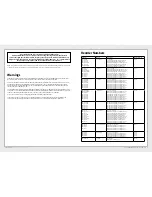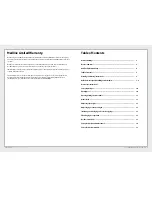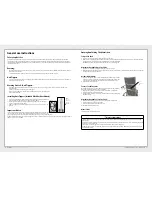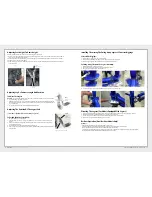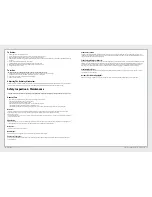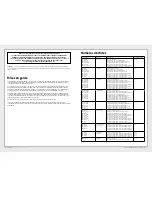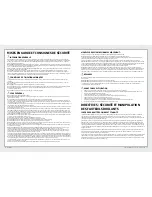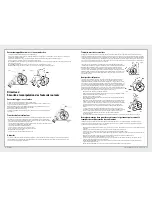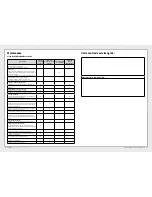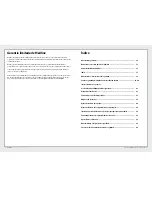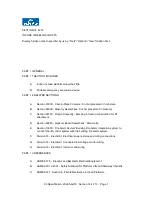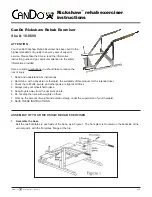
6 MEDLINE
|
MDS806150N | PIC-00270 (Rev: 07-19-16)
1-800-MEDLINE (633-5463)
|
medline.com 7
WARNINGS & SAFETY INSTRUCTIONS
GENERAL INFORMATION
DO NOT
use this product without first reading and understanding the instructions contained in this booklet. If you are unable to understand
the Warnings, Cautions or Instructions, contact a healthcare professional, durable medical equipment dealer or technical personnel, or contact
Medline at 1-800-MEDLINE before use - otherwise serious bodily injury or product damage may occur.
DO NOT
use the wheelchair in a vehicle for transport. This wheelchair has not been approved as a seat surface to be used within a vehicle of any
kind. Always transfer the wheelchair user to an approved vehicle seat and use restraints available from the auto industry for this application.
DO NOT
exceed the weight capacity of the wheelchair listed on page 3. The weight capacity includes the weight of the rider plus items carried
or attached to the wheelchair.
DO NOT
use the wheelchair while weight training. Medline wheelchairs have not been tested for any type of weight training. If the chair is used
during weight training, Medline will not be held liable. If the weight capacity is exceeded, risk of fall, tip-over or loss of control may occur which
can result in bodily injury or product damage.
Use of the seat belt is recommended to maximize safety and stability.
ENVIRONMENTAL
The wheelchair is designed for use on firm, even surfaces such as concrete, asphalt, and indoor floors and carpeting.
DO NOT
operate the wheelchair on loose, slippery, or uneven surfaces such as sand, gravel, hills, dirt roads, or ice.
DO NOT
operate the wheelchair on inclines greater than 10% (6 degrees) without assistance.
DO NOT
attempt to go up or down inclines that are covered with oil, water, ice or any other potentially slippery substance.
DO NOT
attempt to ride over curbs or obstacles. Doing so may cause your wheelchair to tip over and cause bodily harm to you
or damage to the wheelchair.
DO NOT
use the wheelchair on stairs or escalators.
GENERAL USE
DO NOT
stand on the frame of the wheelchair.
DO NOT
stand or put pressure on the footrests. When getting in or out of the wheelchair, make sure the footplates are in the up position.
DO NOT
attempt to lift the wheelchair by armrests or any detachable components.
There are potential finger pinch point areas at moving parts and between the seat frame and the seat cradles on some models. When opening
the wheelchair, take care not to place your hand or fingers between the seat frame and the seat cradles (if present) or on any other moving
parts.
ALWAYS keep hands and fingers away from moving parts. DO NOT sit in the wheelchair until the seat is completely in the open position. Risk of
injury may occur if care is not taken.
The wheelchair should be on a stable, level surface with the wheel locks engaged before transferring the user to or from the wheelchair.
Completely engage the wheel locks when entering and leaving the wheelchair or using the wheelchair in an elevator or a wheelchair lift.
DO NOT
transfer in or out of the wheelchair on your own unless you have sufficient upper body strength, balance and agility and have been
instructed in transfer techniques by a health professional. Every precaution should be taken to reduce the gap distance between the wheelchair
and the target seat or bed. Turn both casters parallel to the object you are transferring to.
DO NOT
use the wheel locks to stop the wheelchair from moving. Wheel locks are not brakes. DO NOT use the wheel locks to slow your descent
down an incline.
Changing direction when going down an incline could cause instability.
DO NOT
lean forward out of the wheelchair any farther than the length of the armrests.
DO NOT
attempt to reach for objects if doing so means you must move forward in the seat.
DO NOT
attempt to reach objects if you have to pick them up from the floor by reaching down between your knees.
DO NOT
shift your weight or sitting position toward the direction you are reaching as the wheelchair may tip over.
DO NOT
attempt to lean over the top of the back upholstery to reach objects.
Before leaning or reaching forward, make sure to rotate the casters straight ahead toward the front of the wheelchair and engage the wheel
locks to prevent the wheelchair from tipping over or moving.
DO NOT
tip the wheelchair without assistance. DO NOT lean the wheelchair back since this can cause the wheelchair to tip over. If trying to
reach objects, reach back only as far as your arm will extend without altering your seating position.
Any person assisting the rider in maneuvering or lifting of the wheelchair must have sufficient strength and be able to see obstacles in the path
of travel. When learning a new assistance technique, have an experienced assistant help you before attempting it alone. Remember to use
good body mechanics.
Contact with water or excess moisture may cause the non-aluminium wheelchairs to rust or corrode. DO NOT use the chair in a shower, pool
or other body of water. Avoid excess moisture (example: do not leave the chair in a damp bathroom while taking a shower). Dry the chair
immediately if exposed to moisture.
When cleaning the hand grips, use only a clean towel lightly dampened with cool water. Ensure the hand grips are dry before use. Use of soap
or ammonia based cleaning solutions may result in the hand grips sliding off.
If the wheelchair is exposed to extreme temperatures, high humidity and/or becomes wet, check the hand grips to ensure they are not loose
and do not twist on the handle.
Avoid storing or using the wheelchair near open flames or combustible smoldering products
RECLINER MODELS ONLY:
Make sure the stabilizer bar is securely attached BEFORE using the wheelchair
DO NOT use the recliner wheelchair without the stabilizer bar securely locked in place.
The push canes must be reclined evenly and stay even during use. The push canes should not be used at different angles. Failure to do so may
result in failure to the push cane.
The Excel Recliner wheelchair MUST be operated by a healthcare professional or assistant when in ANY reclined position. Caregivers MUST be
prepared to support the weight of the occupant when reclining or returning the wheelchair occupant to the full upright position. Use proper
body mechanics when inclining (lifting) the back of the chair.
Completely engage
BOTH
wheel locks before reclining/lifting the occupant of the wheelchair.
Make sure the occupant is properly positioned before the wheelchair is reclined/lifted.
DO NOT
use the Recliner wheelchair without the anti-tip devices installed. Anti-tippers MUST be attached at all times and both must be
adjusted to the same height. Ensure the anti-tippers are secure as evidenced by the spring buttons fully protruding out of the holes. If the seat-
to-floor height is changed, the height of the anti-tippers must also be adjusted. Make sure both canes are at the same angle BEFORE releasing
the handles of the recline mechanism.
ADJUSTMENTS
DO NOT
operate, maintain, or adjust the wheelchair without reading and understanding all instructions in the manual.
DO NOT
adjust the footrests any closer than 2.5” from the floor.
DO NOT
modify the wheelchair. Examples: drilling holes, grinding, welding parts, using non-authorized / non-approved parts. Such
modifications may change the chair’s structure and center of balance which may increase the risk of serious injury to the user and void the
warranty.
BEFORE EACH USE
√
Make sure the chair rolls easily and that all parts work smoothly.
√
Check for noise, vibration, or any change in use. Changes may indicate loose parts or wheelchair damage.
√
Check to ensure wheel locks are in good working order.
√
Make sure hand grips are not loose and cannot be moved or twisted.
√
Make sure the seatback is locked in the upright position.
√
Make sure that lap belt is securely attached to the wheelchair.
√
If chair is damaged, discontinue use until completely repaired.
√
Have any problem found repaired promptly with authorized parts.
GUIDELINES:
SAFETY & HANDLING OF WHEELCHAIRS
CENTER OF GRAVITY, BALANCE AND STABILITY
This Medline wheelchair has been designed to be safe and stable during normal transport activity as long as proper balance is maintained. The
point at which a wheelchair will tip forward, backward, or to the side depends on its center of balance. To assure stability and proper operation
of the wheelchair, the center of gravity must be maintained in the chair. Center of gravity is the point at which all the weight of an object can be
considered to be concentrated and represents the balance point.
Most activities such as transferring in and out of the wheelchair, bending, and reaching affect the center of gravity and weight distribution of
the wheelchair. Addition of accessories such as a backpack will also re-distribute weight. Loss of proper balance may cause the chair to tip
over. Use of the seat belt is advised to help maintain stability by minimizing movement within the wheelchair seat. The use of anti-tip devices,
especially when manoeuvring on ramps or inclines, will also enhance safety. On recliner models, reclining the wheelchair will change the center
of gravity. Anti-tip devices must always be in place.
To assure safe operation of the wheelchair, ALL of the Warnings and Instructions in this manual must be followed. Failure to do so may result in
tipping the wheel chair over or causing the user to fall which may result in serious bodily injury or damage to the wheelchair.
Some basic wheelchair safety guidelines follow. The guidelines are critical for standard wheelchair use, however, the principles also hold true
for transport chairs. If any of the following activities are required while using the wheelchairs, these guidelines must be followed to ensure
safety and to avoid potential injury to the user or the transporter and to avoid damage to the chair.
Содержание Excel 2000 Extra Wilde
Страница 26: ......


